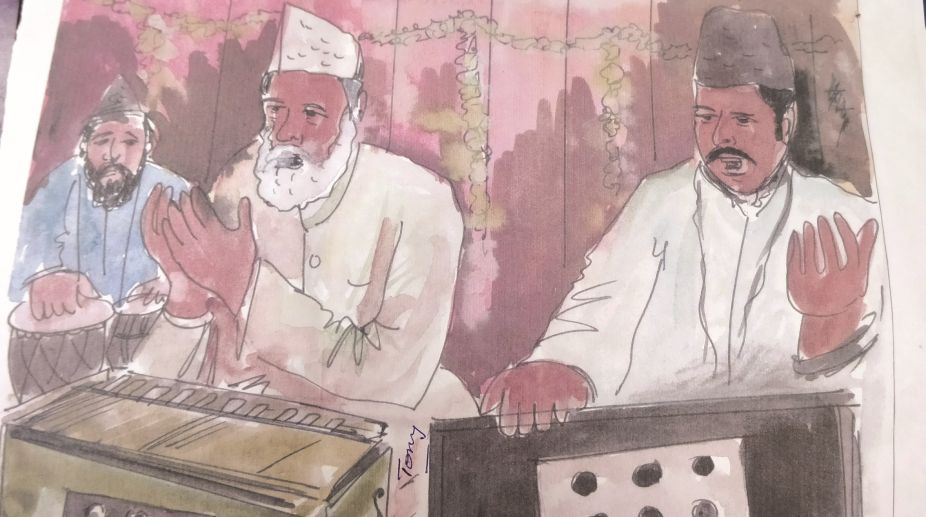While looking up old files one came across this interesting piece of information, collected 22 years ago on behalf of a news agency, which by and large still hold good : “Any foreigner, who has been to the Taj, has seen the great wonder with a pair of cloth-shoes over his footwear.
The practice, however, is centuries old and had evolved at the 900-year-old dargah of Hazrat Nizamuddin Aulia in Delhi for the Britishers, who were not used to taking off their shoes while paying obeisance at religious places.
Advertisement
“Each of the scores of dargahs or shrines built on tombs of Sufi saints that dot the Capital has a story of its own and a distinct tradition that has travelled down the ages. But today many stand on the threshold of oblivion.”
Advertisement
While some of them are among the most sacred of Muslim shrines and draw huge crowds all around the year, they are dying a slow death due to apathy, public ignorance and mismanagement at the hands of the trusts that manage them, say conservationists.
Nalini Thakur, president of the Conservation Society of Delhi, pointed out that most of these dargahs are brilliant pieces of architecture that provide a valuable insight into building trends of the times during which they were constructed.
While time and nature have taken their toll on these “heritage components”, Thakur wanted them to be included in a proposed heritage policy, for the Capital’s growing population and urbanisation have eaten into the once sprawling complexes.
Chirag Dilli takes its name from the fifth Sufi saint, Naseeruddin Mahmud, who was popularly called “Roshan-e-Chirag”. The saint’s dargah, built in 1885-86 in marble and red sandstone, was an architectural marvel, said Archana Gupta, a student of architecture, who has done research on the shrine. “Most of the original construction does not exist today. Locals are not aware of its architectural or historical significance and have, in their attempts to beautify or restore the age-old structure, spoilt it.”
The shrine, even now, draws a crowd of 10,000 at its Urs, which commemorates the birth and death anniversaries of the saint. “What the dargah needs today is financial resources for its restoration,” Gupta said. The dargah of Qutubuddin Bakhtiar Kaki in Mehrauli is yet another shrine that is falling to the greeds of modernisation.
“The tourist map of the city marks a substantial area as the dargah complex. A visit to the place reveals a horde of unauthorised constructions and complexes. One has to inquire around for the dargah,” said Rahul Merchant, a student from Mumbai, rather amazed that conservationists here have not been able to protect valuable heritage sites.
The condition of other vestiges of the secular Sufi tradition is no better. “There were 200 dargahs in Delhi at the time of Mohd Tughlaq,” said Prof Azizuddin Hussain of Jamia Millia Islamia. The figure is significant considering the fact that the 12th century ruler and his father are supposed to have persecuted and even executed some Sufi saints for not recognising the supremancy of the king before God.
Secularism and aloofness from the State were the hallmark of the Sufi movement in India, which dates back to A.D 661. It was established by noblemen, who migrated from West Asia and settled here , said Prof Azizuddin.
“The Sufi saints set up parallel regimes to those of the Sultans all over India, strictly keeping away from the Sultans and their grants. It is not known when the Sufis started accepting money from the kings. But Emperor Akbar, who developed the dargah of Khwaja Moinuddin Chisti in Ajmer as a pilgrim centre, is regarded as one of their most known patrons.”
Their monasteries or “khankhas”, have chronicles providing valuable information of that age. “Unlike a khankha, where the peer was replaced by another on his death, the dargah tradition started when one of the disciples of the peer built a memorial over his tomb and started worshipping it as a shrine,” disclosed Khawaja Hasan Sani Nizami.
Offerings at the dargah marked its commercialisation, which has ony deteriorated over the years at the hands of what he called greedy managers, who were party to the mushrooming of illegal construction there. Nizami , who was a member of the trust that manages Nizamuddin Aulia’s shrine, asserted in the 1960s that financial offerings at the dargah were enough to run a university.
“But the money as being siphoned off instead of being used for the shrine’s upkeep and restoration.” Nizami, however, was more supportive of the idea of creating awareness among the public and involving the masses for protection off all heritage sites. Inspired by the environmentalist Sunderlal Bahuguna, Nizami suggested a Chipko-like movement.
Khandelwal, a retired civil servant, said public awareness must be coupled with schools and educational institutions, including history of the locality in their curricula to educate the children.
Thakur had said efforts at the voluntary levels would have to be supplemented by the Delhi government, which just cannot shy away. But time seems to be running out. Thakur said Nizamuddin Aulia’s dargah was a fascinating part of Delhi 50 years ago. The shrine has changed much in these years “but in the future you won’t see what you see now”.
The Nizamuddin dargah, however, is now better maintained after renovation, especially of the Baoli, or step-well, under the Aga Khan Trust for Art and Culture.
A few of the shrines and old masjids have been saved from ruination with help from philanthropists and funds received from the Gulf countries, but many others are still lying neglected and may disappear in course of time if vandalism and encroachment are not checked. This may eventually prove the words of the poet Marris Akhbarabadi true:
“Bela is gone and
Champa Chameli too
Vast Takia of my
Khwaja lies bereft
Sans fragrance ~ just Dome and minaret of a sigh!”
Bela was Prithviraj Chauhan’s daughter, whose Samadhi in Jhandewalan is not traceable now. “Champa Chameli” was one of her maids of honour, like Charmion was of Cleopatra, and the Takia or courtyard of Khwaja Qutubuddin Bakhtar Kaki in Mehrauli looks more desolate than ever before.
When Sher Ali Mewati met Jawaharlal Nehru in the early 1960s, along with a delegation of hertitage activists, to protest against the demolition of some famous graves in the Mehdian loactily, the Prime Minister curtly told them, “Gentlemen, do you want to live in a graveyard or in a modern city?” He, however, later relented and ordered an inquiry. So the graves of the “Wahabi” saints were restored.
Multan (now in Pakistan) has the largest number of graves. Hence the saying, “Mar Ke Multan paunch gaye (Reached Multan after death)”. Delhi and Agra should come second and third after it. Most at these places are Muslim graves, though Christian, Jewish and Parsi tombs are also there, along with Hindu samadhis. The more important among them should definitely be preserved.
And that goes for the Sufi dargahs too though the Capital is dotted with them. But even so, they are a part of our cherished heritage and just cannot be bulldozed at the whims of the government and land-hungry colonizers or Delhi would one day be bereft of a vital part of its history.
R V Smith
Advertisement











